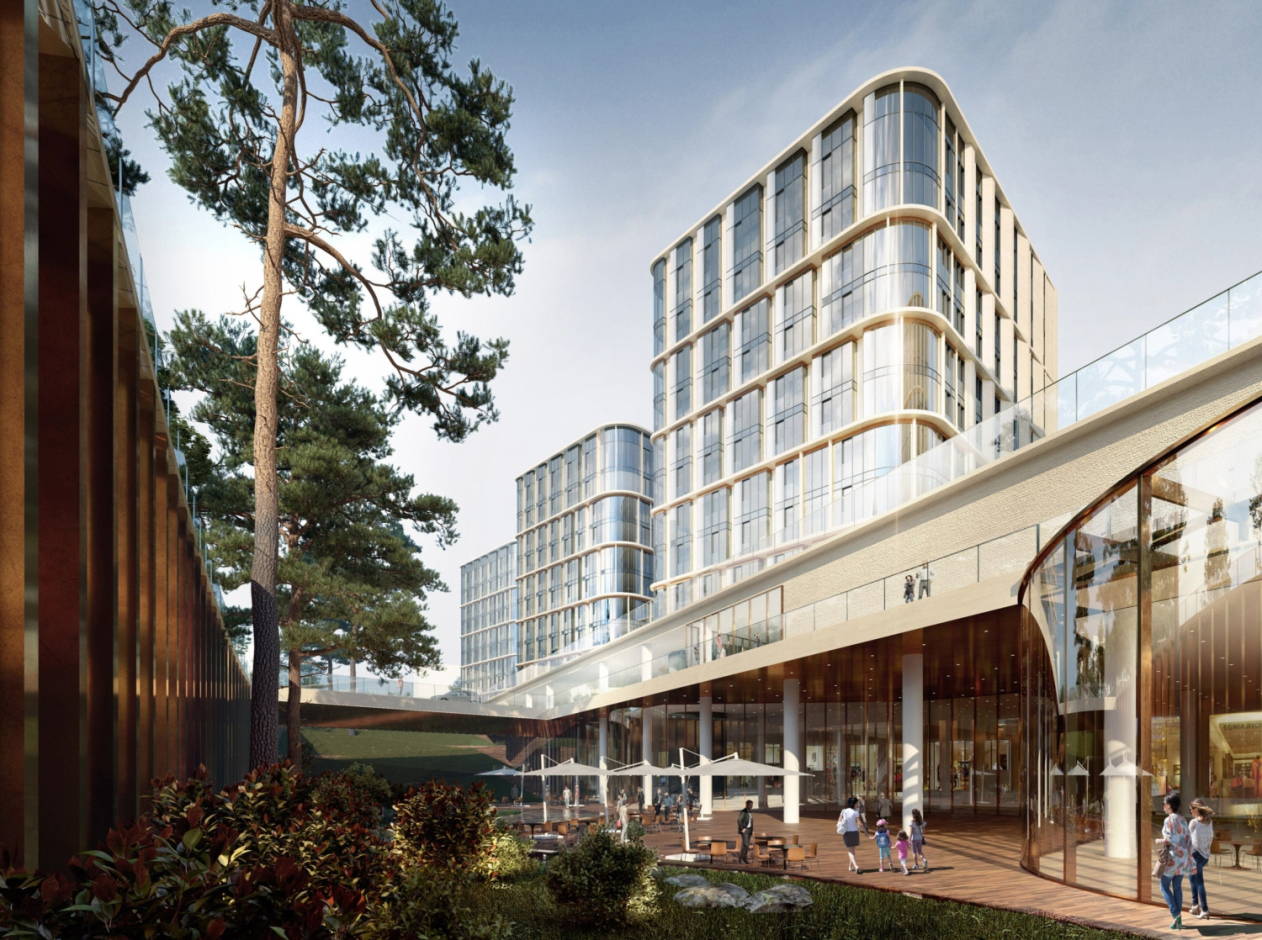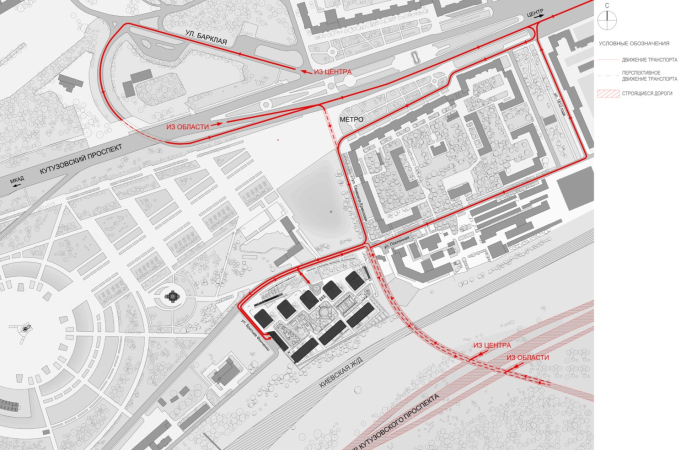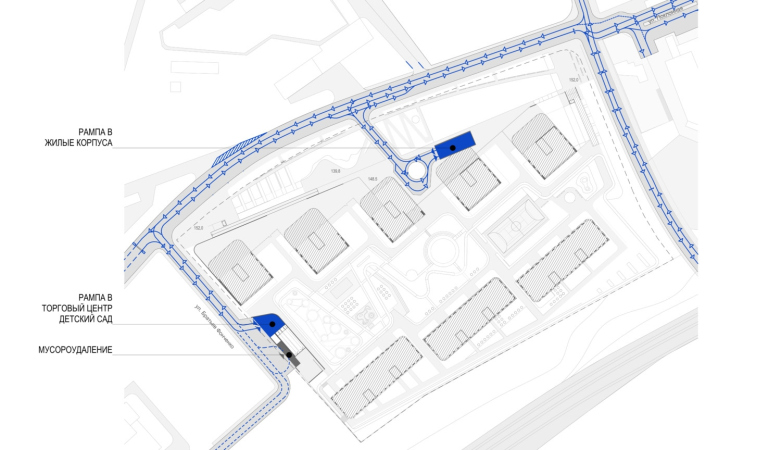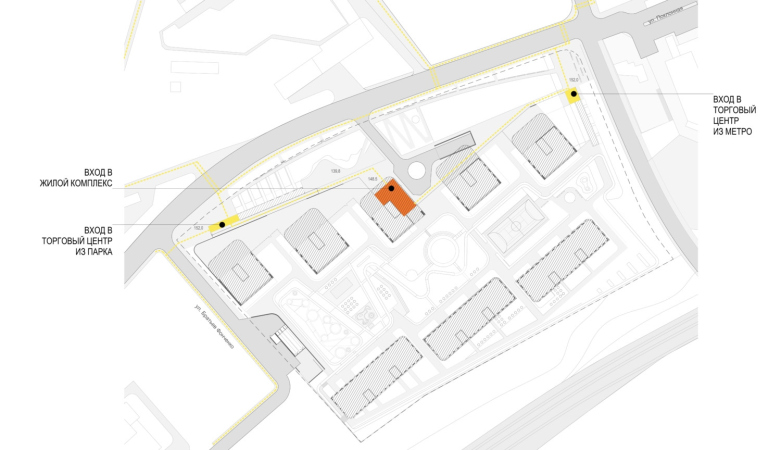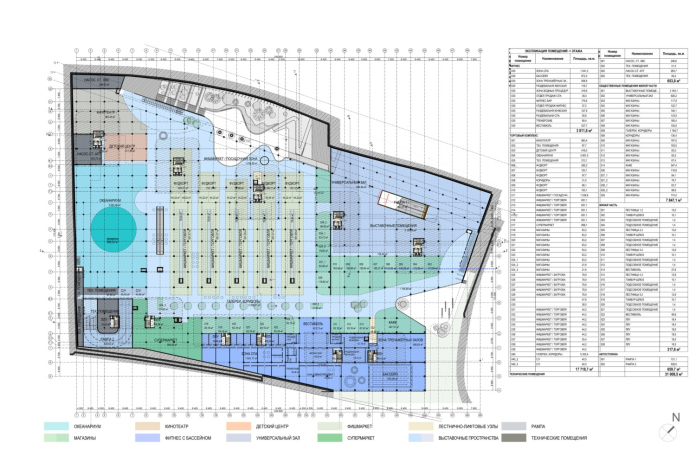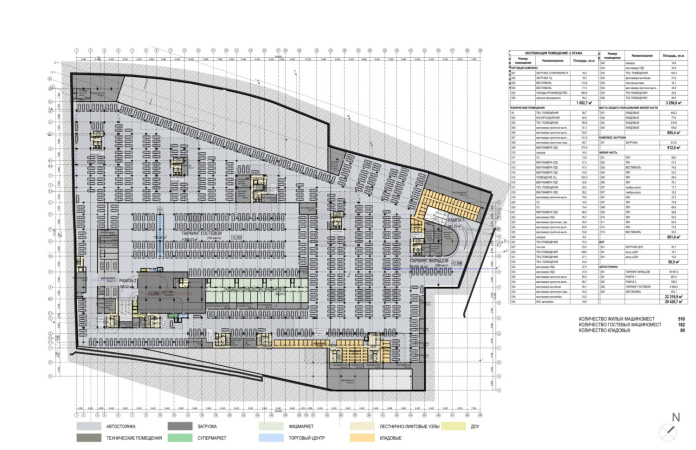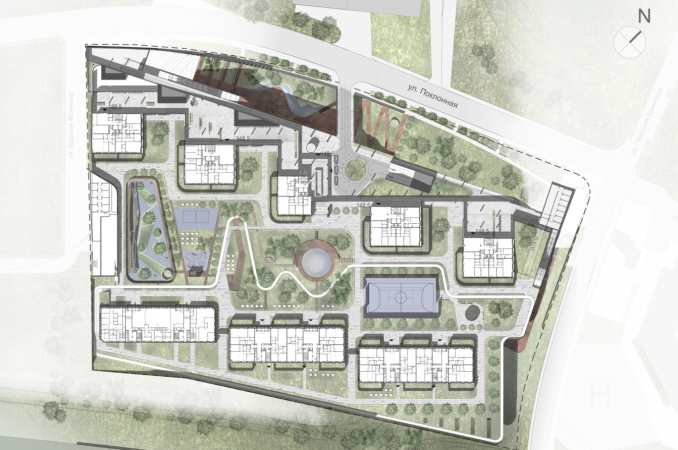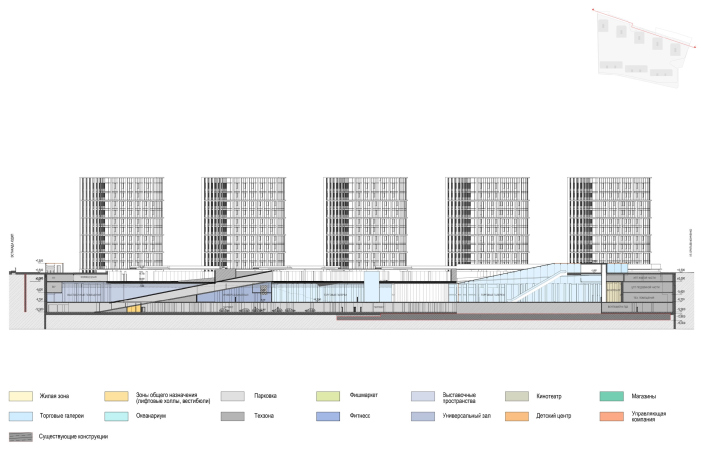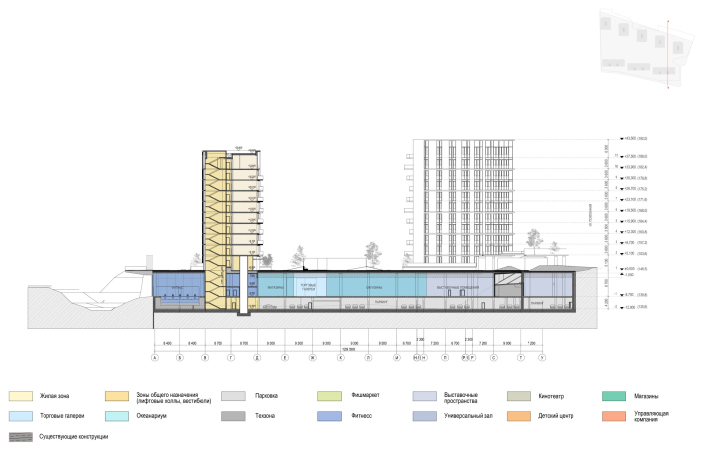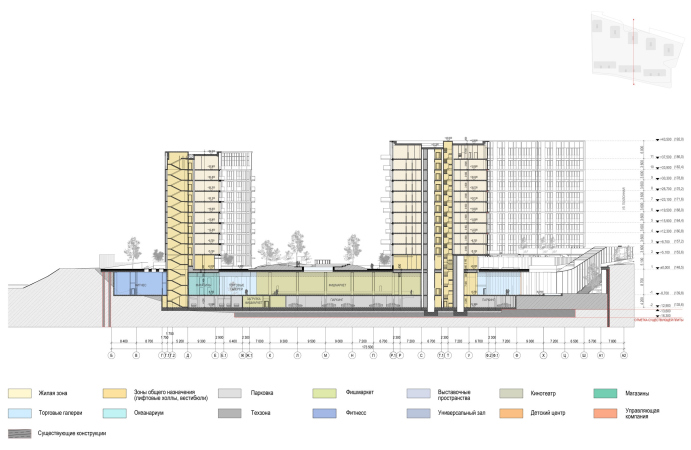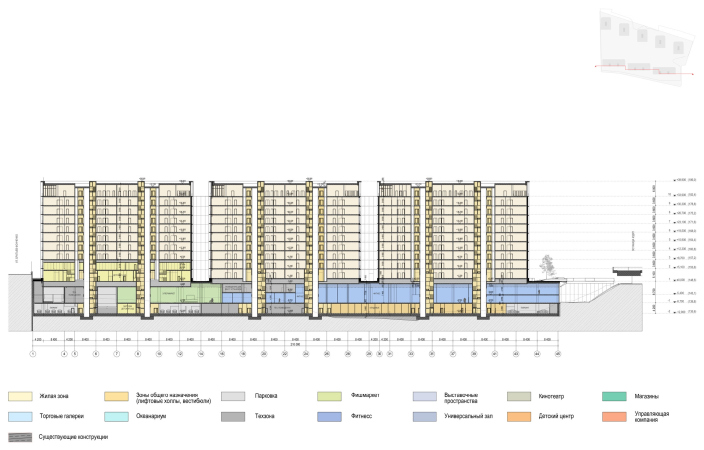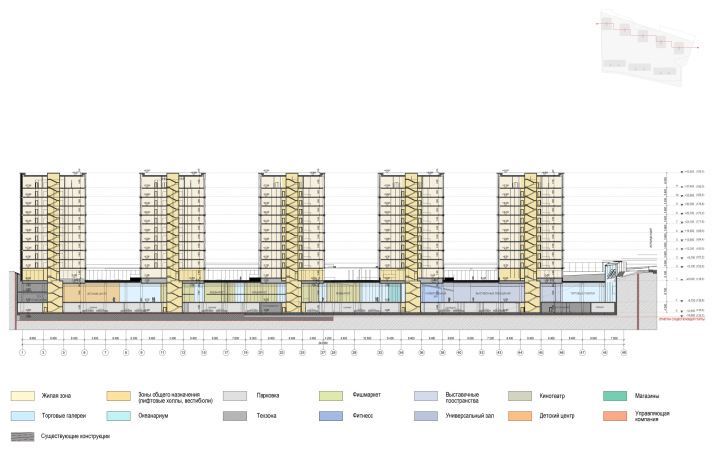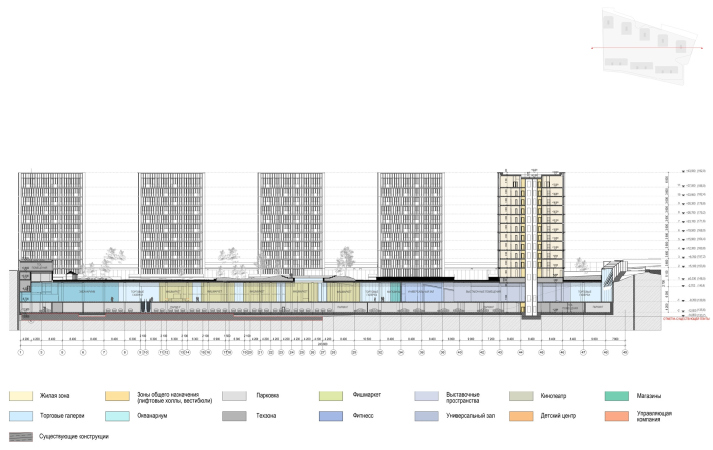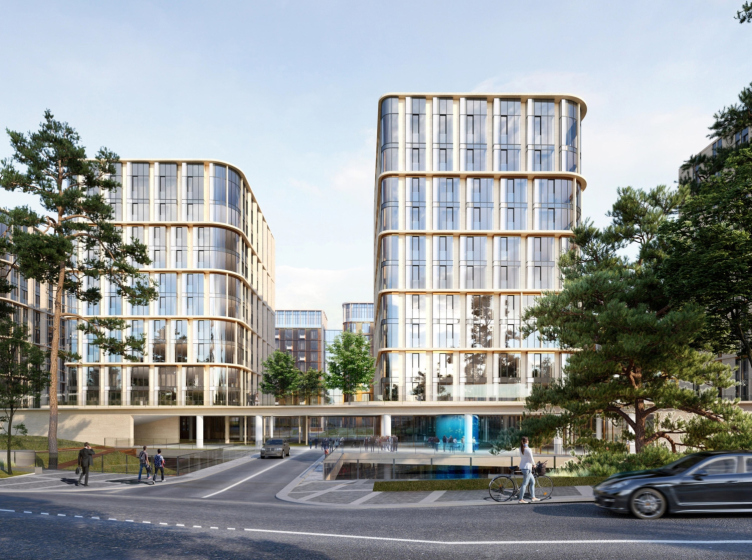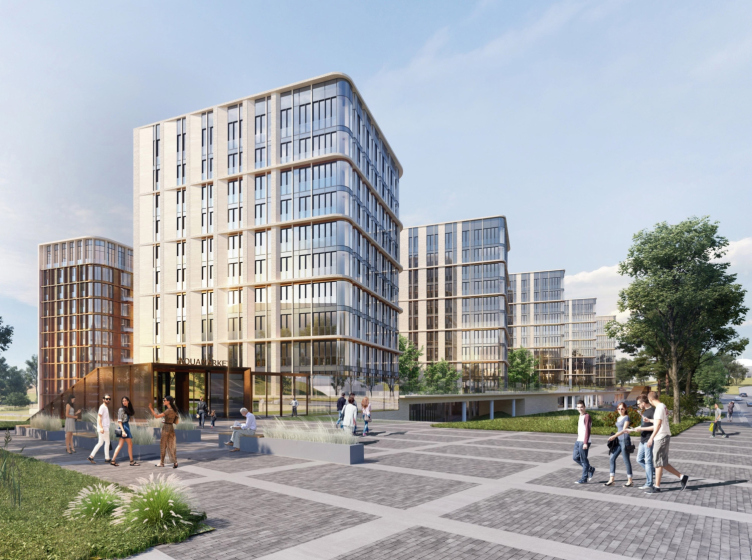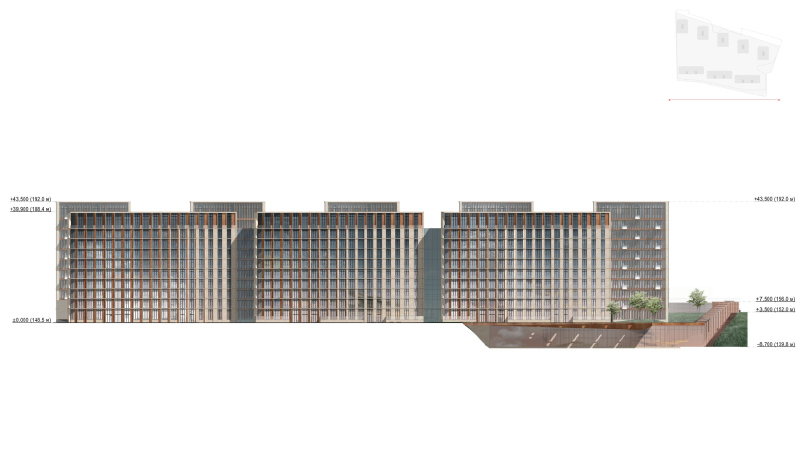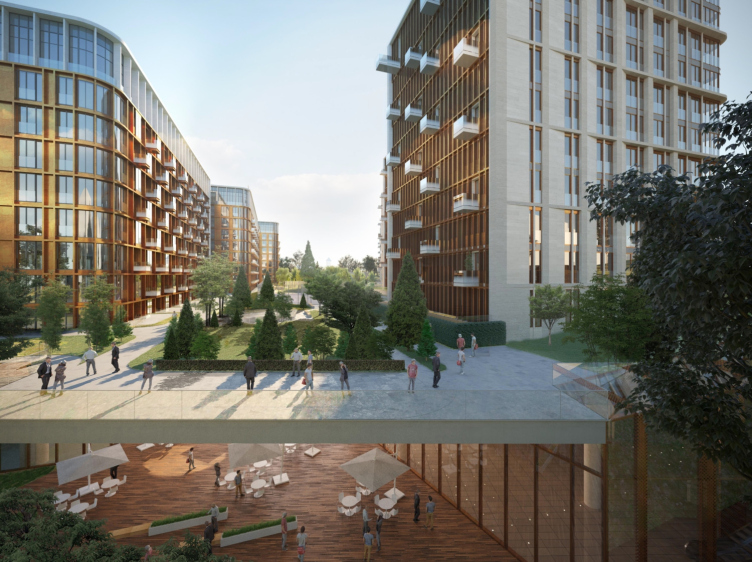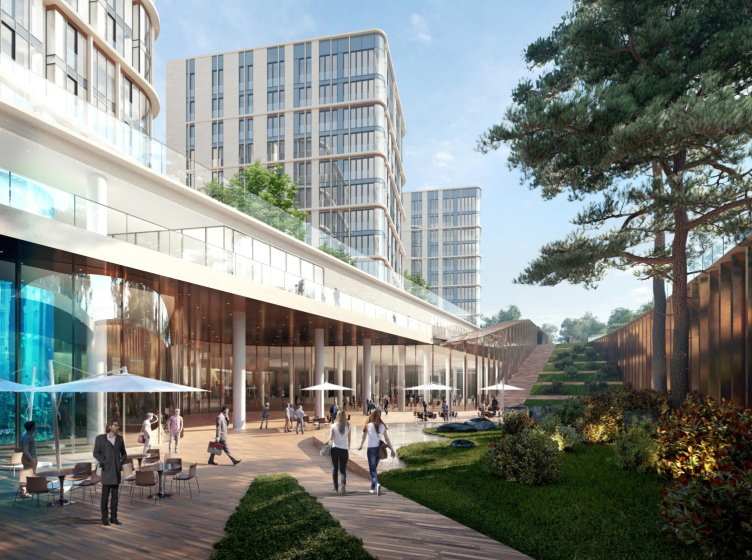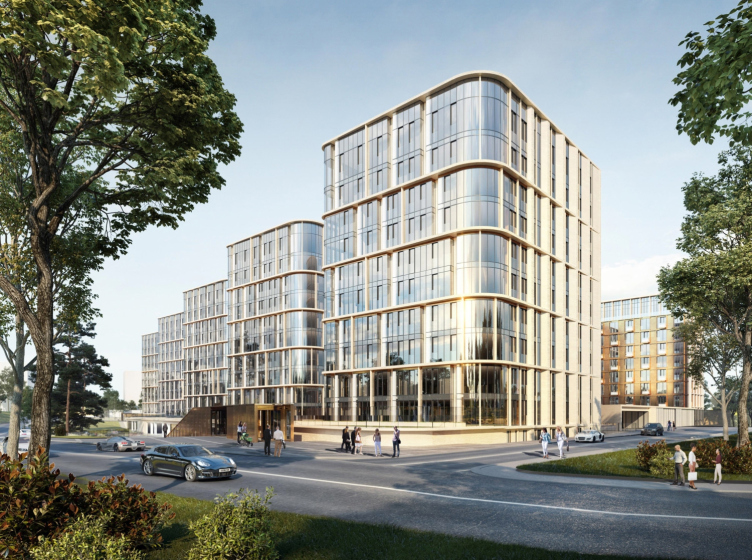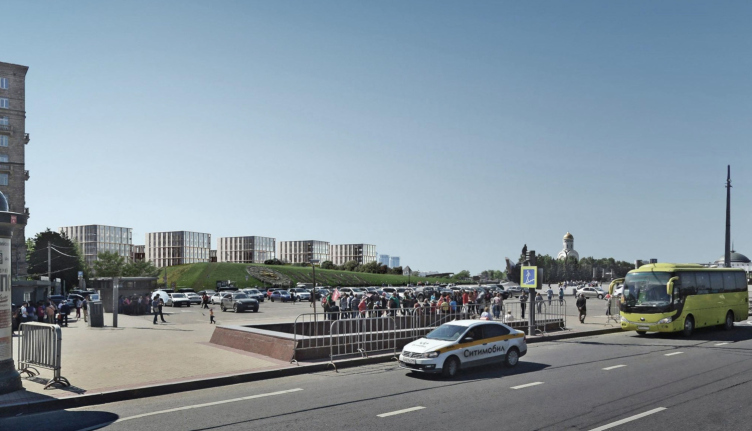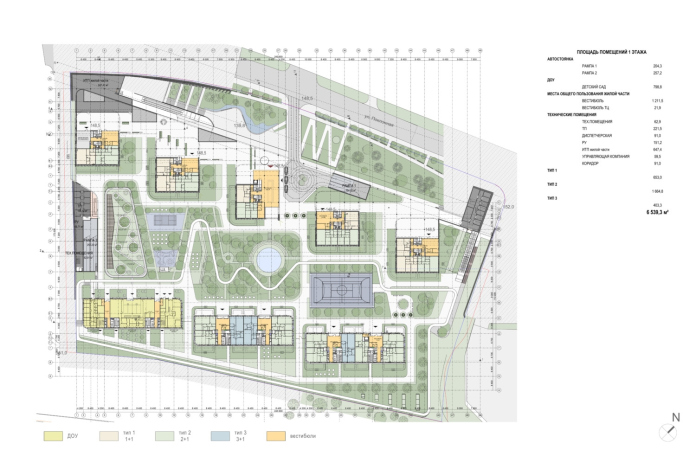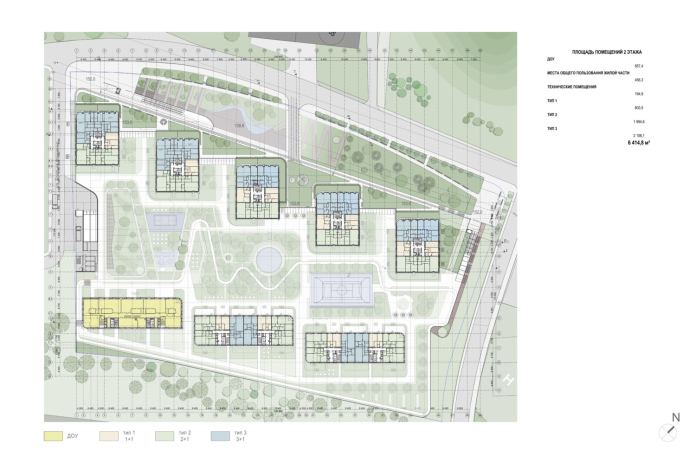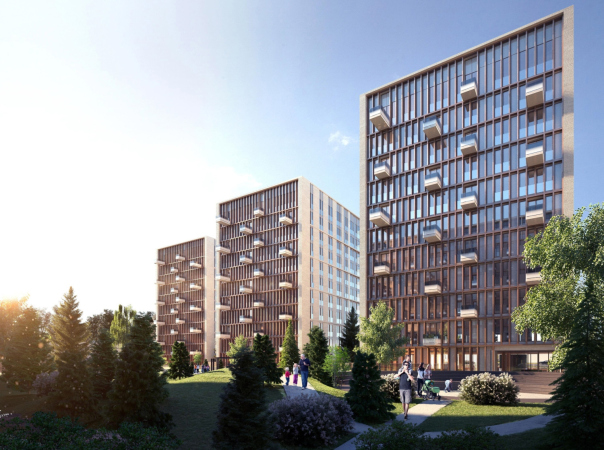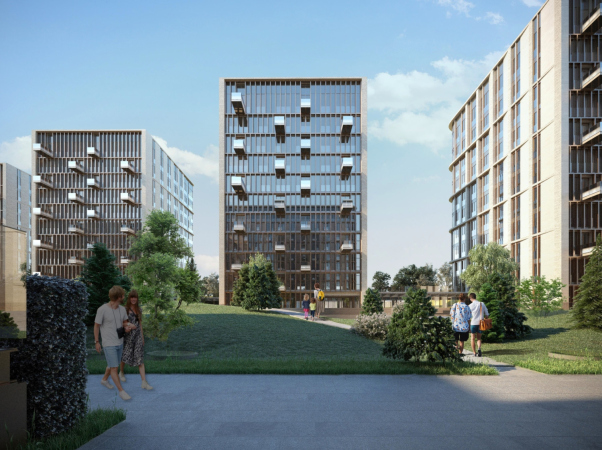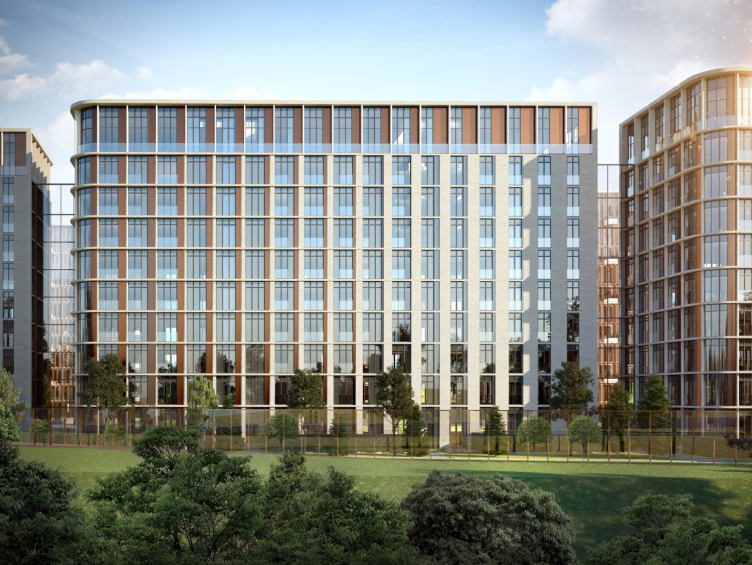The House on Fonchenko Brothers Street
Copyright: © Sergey Skuratov architects
The land site is situated between the “entrance” eastern part of the park of the Poklonnaya Hill and a railway line of the Kiev railroad; it takes 5 minutes to get here from Moskva-Sortirovochnaya station. The western boundary of the complex is marked by the Bratiev Fonchenko Street, while the park is separated from the complex by the quiet two-lane Poklonnaya Street. However, east of the Victory Park grounds, there will be a road junction leading from General Dorokhov Avenue and the Third Transport Ring towards Barklaya Street. The new complex steps back from the railroad line and from the junction 50 and 25 meters respectively.
The specifics of the surroundings are first of all defined by the proximity of the Pobedy Park, the “Great Creation by Anatoly Polyansky”, as Sergey Skuratov describes it. The complex not just repeats the “victorious” name of the park but also continues its planning grid, turned at an angle to Kutuzovsky Avenue, from the stele in front of the museum, and towards the Triumphal Arch, designed by Osip Bove. The five buildings that stand along the Poklonnaya Street symbolically, on a diminished scale, respond to the five traversal alleys – the memorial grounds of the front part of the park symbolizing the five years of the Great Patriotic War – the author explains.
The House on Fonchenko Brothers Street
Copyright: © Sergey Skuratov architects
The northern line of residential buildings consists of five single-entrance towers, which allows the complex to be opened towards the Pobedy Park memorial complex, to emphasize the spatial connections with it, and provide more views towards it. The three buildings standing along the south border, on the other hand, are stretched lengthwise. These buildings, just like the transparent screens between them, are meant to protect the yard from the noise and the grime of the railroad – even though the buildings themselves are, of course, also protected from the noise, first of all, by glass units. Thus, the Victory Park complex stands with its “back” to the railway and its “face” to the park of the Poklonnaya Hill, just as to the avenue and the path from the namesake metro station.
The House on Fonchenko Brothers Street
Copyright: © Sergey Skuratov architects
It must be said that the history of the land site, on which the complex is built is rather complicated: in the mid 2000’s, the city had plans to build here the Eastern Europe’s largest aquarium called “Poseidon Park”. A competition was organized, construction began in 2008, and a construction pit for two underground floors was dug out. The project uses the already-existing pit, and the idea of the aquarium “grew” into the sophisticated multifunctional space of the stylobate. Curiously, the designed functions do preserve a small – about 3000 sqm – aquarium in the western part, with a movie theater and a children’s center next to it, a little more to the north. In the northeast corner of the stylobate, closer to the metro station, there is an expo complex, the southeast part includes a fitness center with a SPA and a swimming pool, and the southeast one is occupied by a supermarket. The central space is occupied by a food court and a fish market, surrounded by cafes and shops, with an inner boulevard running in the middle. On the one hand, typologically, this is a sophisticated shopping mall with elements of a community center; on the other hand, this is a semblance of a city under a roof, grouped around the “market square”.
The public stylobate is situated on the minus first floor; the height of its ceilings is really high – a whopping 8 meters! Still lower, on the minus-second floor, there is an underground parking garage. Designing the stylobate, the architects masterfully used the height difference – and here it is both considerable, a little over 12 meters, and convenient, because from the side of the park and the metro the relief is raised, which allowed the architects to organized barrier-less entrances over the slopes, ramps, and straight through the bridge. From the south side, the height difference allowed the architects, first of all, to open the façade of the swimming pool in the fitness club to natural light, and, second, to elevate the private yard of the residential buildings on the roof of the stylobate, thus putting as much distance as possible between the yard and the railway line. On the inside, the spaces are interwoven – literally bound – with ramps, escalators, and travelators, which makes examining the structure in a section view rather exciting. In addition, the residents will be able to go down to the public area by elevator directly from the apartments.
In addition to the fact that this whole structure allowed the architects to fulfill the challenging task posed by the developer and find room for the required functions on the land site, conveniently arranging them, it also creates a spatial intrigue. Already looking at the section views and 3D renders, one can feel that due to all these height drops, slopes and bridges, things on the inside will be far from trivial.
On the roof of the stylobate, there is a courtyard of the residential complex with geoplastics and trees. Its surface is strictly horizontal; we will remind you that it is raised 12-something meters above the drive on the side of the railroad line, while from the side of the park – approximately in the middle of the north façade – it is accessed by a bridge, by which one will be able to get into the yard by foot, or drive from the Poklonnaya Hill to the ramp that leads to the underground parking garage. On this side, there is a gallery running in front of the residential buildings – some kind of portico with trees on top; it delicately separates the yard of the complex from the city street.
The House on Fonchenko Brothers Street
Copyright: © Sergey Skuratov architects
While you can enter the residential courtyard from the north side in a straight line, the entrances to the public parts of the stylobate, on the contrary, go up and down. The raised “head” of the corten “snake” in the northern corner accentuates the entrance from the metro station to the expo center. A similar “entrance head” on the northwest corner, on the side of the park, leads to the aquarium and to the movie theater.
The House on Fonchenko Brothers Street
Copyright: © Sergey Skuratov architects
However, in both cases you can also take parallel paths – on the slope, gradually sinking underground in the cozy inclined park.
The intrigue is that, in addition to the convenient separation of flows, the complex constantly offers us new spatial sensations, making us experience this space as indoor, outdoor, ostentatiously inclined, or, by contrast, with a straight surface underneath your feet. Different areas feature different shades of color and have different lighting angles; you will get lots of interesting impressions just by walking around here among these height drops and slopes. And we will also note that from the top level you can look down, and vice versa – they are also visually connected. It is expected that being here one will always feel the multilayered character of the stylobate: sometimes, there are two tiers, and sometimes, on the side of the north gallery, even three.
The House on Fonchenko Brothers Street
Copyright: © Sergey Skuratov architects
The slopes that lead to the multifunctional stylobate stop at small open-air plazas with terraced cafes – a kind of oasis of comfortable environment that we tend to associate with the central districts of European cities. The cafes are cozy and securely protected from the wind – their windows, as well as the windows of the shops emphasize the urban character of this space, inviting to wander between boutiques and café tables.
The House on Fonchenko Brothers Street
Copyright: © Sergey Skuratov architects
One must note that Sergey Skuratov – and he also stressed this in his interview – has long since been exploring the idea of a multilayered city space, which is a rather rare phenomenon by the standards of Moscow and other post-soviet cities, predictably flat en masse. As a rule, Sergey Skuratov creates around his buildings some sort of spatial intrigue that is one way or another connected to the surrounding city: it is composed of powerful or “head turning” cantilevered structures, of unconventional paving with Klinker brick, of areaways that form quiet passages by the shop windows, and, of course, of height differences. The houses that he designed – Egodom and Art House, the house in Tessinsky-1, and Skouratov House on the Burdenko Street – seem to embrace the height differences that they are challenged to cope with, because such height differences perfectly match the scenario of a “sculptural” city.
But, of course, the most complex multi-level spaces have been created in the Garden Quarters residential complex with its bridges in the courtyards, the end-to-end “Road to School” and a public plaza in the center: significant height differences in the artificial terrain form at least three levels of perception and in total give a very special aesthetic tension even if you take a simple walk through the complex: it literally makes you “read” itself not just horizontally, but also vertically, examining it from top to bottom, evaluating the height and the benefits of vertical thinking. Probably, Victory Park is the most vivid example of developing the ideas first used in Garden Quarters. It will be exciting to examine it in detail after the construction is completed.
While the public part combines glass and Corten steel, the main facades of the buildings overlooking the park consist of stone and glass, the stories being grouped in twos, the verticals growing gradually thinner on the side of the park, and the glass on the rounded corners also being curvilinear, which allowed the architect to highlight the exclusiveness of its “precious” texture: the futuristic glass looks like some kind of force field, stretched between the slender verticals.
The House on Fonchenko Brothers Street
Copyright: © Sergey Skuratov architects
The lintels will be coated with light-beige dolomite, whose color matches that of the facades of the Victory Museum – yet another tribute to the proximity of the memorial park. Let us note, however, that their color is slightly brighter than that of the “Stalin” houses of the Kutuzovsky Avenue, yet still reminiscent of them; besides, observing the height restrictions, the 10-11 story houses pick up the height of the neighboring buildings. However, due to the fact that Victory Park stands 330 meters back from the avenue’s redline, from this side it looks like a remote city block, partially obscured by the hill: the houses even look as if they were lower in height than the St. George Chapel in the foreground. Thus, we can quite agree with Sergey Skuratov’s words about the complex “dissolving” in space – in the current state, the line of the houses coming up to the Poklonnaya Hill breaks abruptly, and after Victory Park is completed, it will receded gradually, smoothly taking on a more dispersed character – the wall will give way to an array of independent volumes with a gradient string of vertical “stele” piers, whose austere order, just as the color of the stone they are made of, is also reminiscent of the colonnades of the Victory Museum.
The House on Fonchenko Brothers Street, a project. Simulation, view from the Kutuzovsky Avenue.
Copyright: © Sergey Skuratov architects
The apartments, many of which, matching the class of the housing, are quite spacious, up to 300 sqm in the penthouses, have panoramic windows reaching to the floor that will command beautiful park views – the best lots are on this side.
The yard facades are different from the outside ones: they will be decorated with reddish metal, Corten or copper; the close grid, vertically oriented, looks like crystal cell – as if the “limestone rocks” of the houses were slit through, and a yard appeared in the gorge. Above its hills and trees, however, overhang, like rocky cantilevers, balconies of different outsets – yet another level of space perception, this time for the residents of the apartments.
The facades of the three longitudinal buildings on the south side are designed slightly differently – the copper is more abundant here, the piers are wider, and the penthouses are accentuated. Even here, however, we can say that copper meets stone in a gradient rhythm that echoes the pattern of the side facades of the towers.
The House on Fonchenko Brothers Street
Copyright: © Sergey Skuratov architects
The House on Fonchenko Brothers Street
Copyright: © Sergey Skuratov architects
Summing up, one can say that the project of Victory Park Residences has a lot of Sergey Skuratov’s signature techniques about it – so much so that, probably, one can already say that Moscow is getting a whole number of premium-class residential complexes authored by this architect. They all are characterized by close attention to the surrounding landscape – in a sense, they “grow into” the land site or “grow out” of it, forming around themselves sophisticated urban space – unusual for Moscow people, yet defined both by the context and the specifics of the territory, which means that the building “takes root”. Another peculiar feature is a combination of rather laconic modern shapes with texture, color, and plastique diversity: if we take a tour around these buildings, they will always feel slightly different when viewed from a different angle – the facades, just as the multilevel space of the stylobate, will leave you without a chance of getting bored – yet at the same time they are rather reserved-looking. This is exactly the kind of house that should be built on the border of Moscow’s main memorial park – whose vicinity is doubtlessly more than obliging.

